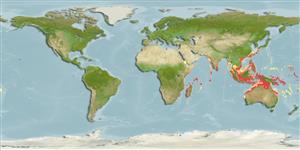Malacostraca |
Stomatopoda |
Squillidae
Environment: milieu / climate zone / djupintervall / distribution range
Ekologi
; djupintervall 0 - 80 m (Ref. 80410). Tropical
Indo-West Pacific.
Length at first maturity / Size / Weight / Age
Könsmognad: Lm ? range ? - ? cm
Known from intertidal to 80 m deep (Ref. 80410). Stomatopods are predators that require living prey (Ref. 833).
Life cycle and mating behavior
Könsmognad | Reproduktion | Lek | Eggs | Fecundity | Larvae
Some members of the order Stomatopoda pair for life and some come together only to mate. Males produce sperm ducts rather than spermatophores; females can brood a maximum of 50,000 eggs. Life cycle: Eggs hatch to a planktonic zoea which lasts for 3 months.
Manning, R.B. 1990 Stomatopod Crustacea from the Persian Gulf, with the description of a new Manningia. Steenstrupia 16(6):93-108. (Ref. 3533)
IUCN Red List Status
(Ref. 130435: Version 2025-1)
CITES status (Ref. 108899)
Not Evaluated
Not Evaluated
Threat to humans
Harmless
Human uses
| FishSource |
Verktyg
Ytterligare information
Trophic EcologyFood items (preys)
Födosammansättning
Födointag
Predatorer
Population dynamicsTillväxt
Max. ages / sizes
Length-weight rel.
Length-length rel.
Length-frequencies
Mass conversion
Abundans
PhysiologySyreförbrukning
Human RelatedStamps, coins, misc.
Internet-källor
Estimates based on models
Preferred temperature
(Ref.
115969): 24.7 - 29.1, mean 28.2 (based on 1552 cells).
